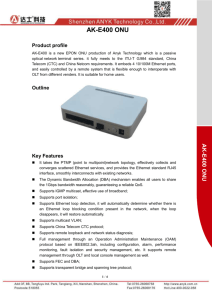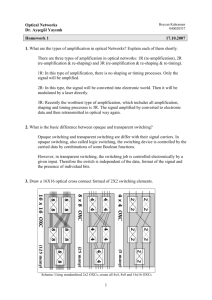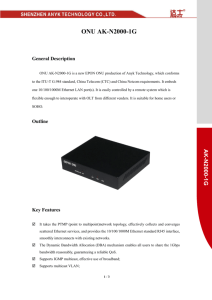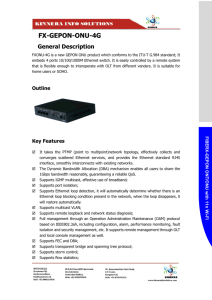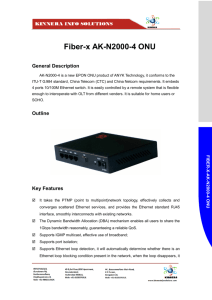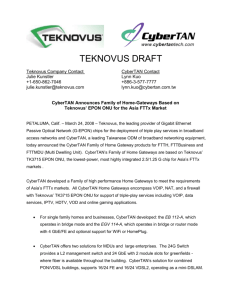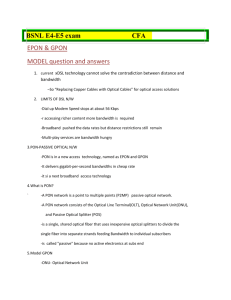Term Project: Ethernet Passive Optical Network (EPON): Enabler of
advertisement
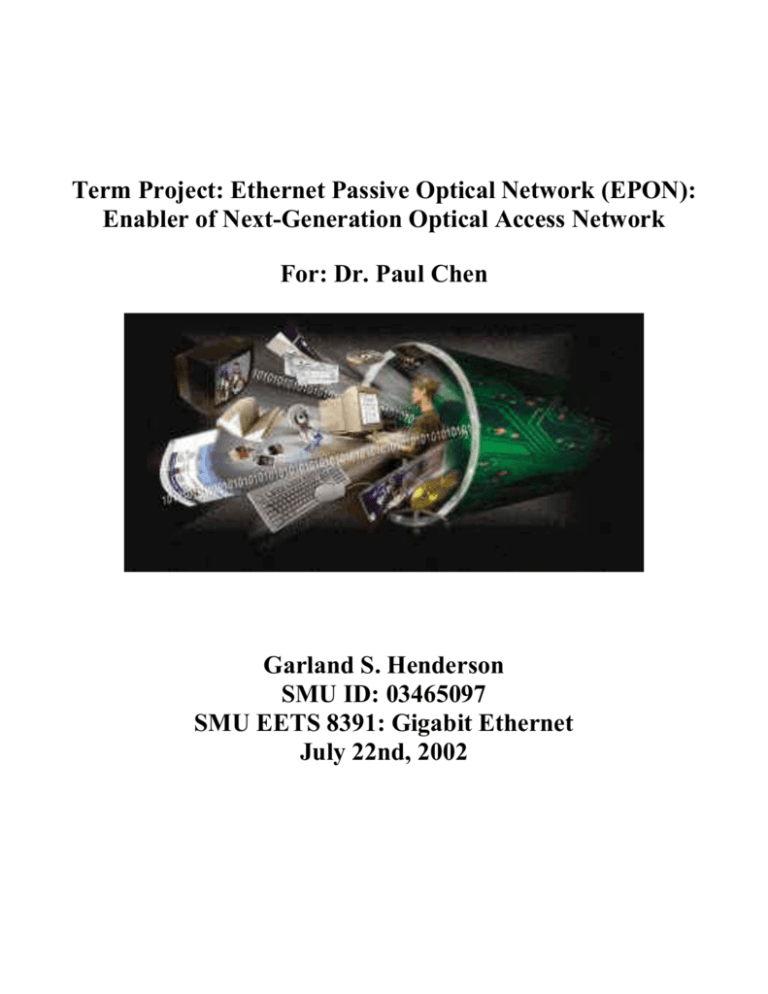
Term Project: Ethernet Passive Optical Network (EPON): Enabler of Next-Generation Optical Access Network For: Dr. Paul Chen Garland S. Henderson SMU ID: 03465097 SMU EETS 8391: Gigabit Ethernet July 22nd, 2002 Problem Statement: Communication infrastructures are experiencing explosive traffic growth where data traffic has grown by more than 100% per year since 1990. In 1995 and 1996, this traffic grew by more than 1000%. [Kramer, 02] Driven by the Internet and associated bandwidthhungry applications, data traffic is doubling every 100 to 120 days and has surpassed voice traffic. Comparatively, voice traffic has historically grown at five percent to seven percent annually. [Langowski, 01] As the backbone has an overabundance of bandwidth and dark fiber, the bandwidth throughput limit in the “Last Mile” is hampering roll-out of next generation services, like bundled voice, data, & video services to businesses and residences. Even Congress wants to fix the problem, as seen in the recent Tauzin-Dingell Bill. Current broadband solutions to the last mile have many problems. Cable modems are expensive and have slow speeds during shared peak periods. DSL is distance limited from Central Office Switch (5.5km) and is too slow for future services. [Kramer, 02] With Ethernet becoming the protocol of choice for IP transport and is increasing its capability to the 10 Gigabit per second range, Ethernet Passive Optical Networks (EPONs) could be the solution for cost-effectively extending the high speed backbone to a multiservice environment for end users by converging low-cost Ethernet equipment and low-cost point-to-multipoint fiber infrastructure. [Silverton, 01] Objective: This report presents an overview of Ethernet Passive Optical Networks (EPONs) as the most likely standard for the next generation access network, further extending on-going metro optical network build-outs to the end user. The report discusses the strengths and weaknesses of the EPON approach. The report gives a synopsis of the EPON architecture and discusses how EPON capitalizes on the robust implementation of Ethernet over fiber, along with a detailed description of how EPON works. Details of the EPON transmission and framing mechanisms are given. Next, the report provides details of the EPON control functionality, and discusses how EPON provides for QoS and SLA fulfillment. Throughout, the report provides specifics pertaining to how EPON enhances service at low costs. The report provides the status of the IEEE P802.3ah, the proposed EPON standard. Cost performance data is provided that supports the migration to EPON, as well as EPON-related market projections. Finally, the maturity and robustness of EPON is cited through a series of vendor success anecdotes. Ethernet Passive Optical Networks (EPONs) Overview: EPONs are an emerging access network technology, providing a low-cost method of deploying optical access lines between headend and customer. EPONs build on the ITU standard G.983 for asynchronous transfer mode PONs (APONs) and deliver converged data, video, and voice over optical access system. The EPON concept offers higher bandwidth, lower costs, and broader service capabilities than APON, although the architecture is broadly similar and adheres to many of the same G.983 principles. As industry moves to gigabit Ethernet/10-gigabit Ethernet, EPON proponents believe EPONs will eliminate the need for APON conversion between ATM and IP protocols in the WAN/LAN. In November 2000, a group of IEEE Ethernet vendors initiated their own standardization effort, forming the Ethernet in the First Mile (EFM) study group, consisting of sixty-nine companies, including 3Com, Alloptic, Cisco Systems, Intel, and MCI WorldCom. The EFM study group was formed within the IEEE 802.3 carrier sense multiple access with collision detection (CSMA/CD) Working Group, called IEEE P802.3ah EFM Task Force. [IEC-EPON, 02] The case for EPON is even stronger when considering the recent 10-gigabit Ethernet standard, especially when the ATM “cell tax” is considered. Garland S. Henderson – EETS8391 Term Paper Page 2 of 9 [IEC-Opt-Eth, 02] Due to the constrained project length, this paper will focus on EPON’s Point-to-Multipoint (P2MP) Proposed standard since its strengths seem to hold the most promise for optical broadband adoption. EPON’s strength lies in its simplicity: a single trunk fiber from a cable headend/central office through a passive optical splitter, to multiple optical drop fibers. It is “passive” because no component requires electrical power other than terminating equipment. Finally, this design minimizes fiber infrastructure while capitalizing on Ethernet emerging as protocol of choice for carrying IP in metro/access networks. [Pesavento, 01] Functional Requirements Match Performance Requirements: EPON has an optical system design for multiple access and multiple services. While EPONs can be implemented using either a twowavelength or a three-wavelength design, the two-wavelength design is suitable for delivering data, voice, and IP–switched digital video (SDV). In two-wavelength architecture, the 1510 nm wavelength carries data, video, and voice downstream, while a 1310 nm wavelength is used to carry video-on-demand (VOD)/channel change requests, as well as data and voice, upstream. Using a 1.25 Gbps bidirectional PON, the optical loss with this architecture gives the PON a reach of 20 km over 32 splits. For further functionality, a three-wavelength design is required to provide radio frequency (RF) video services (CATV) or future dense wavelength division multiplexing (DWDM) expansion. Below is the optical layout for a three-wavelength EPON. In this architecture, 1510 nm and 1310 nm wavelengths are used in the downstream and the upstream directions respectively, while the 1550 nm wavelength is reserved for downstream video. The video is encoded as Moving Pictures Experts Group–Layer 2 (MPEG2) and is carried over quadrature amplitude modulation (QAM) carriers. Using this setup, the PON has an effective range of 18 km over 32 splits. [IEC-EPON, 02], [Kramer, 02] From a transmission perspective, EPON data is transmitted in variable-length packets of up to 1,518 bytes according to the IEEE 802.3 protocol for Ethernet (not fixed-length 53-byte cells as specified by the ATM protocol – with an “ATM cell tax.”). The IP calls Garland S. Henderson – EETS8391 Term Paper Page 3 of 9 for data to be segmented into variable-length packets of up to 65,535 bytes. In an EPON, the process of transmitting data downstream from the Optical Line Terminal (OLT, at service provider) to multiple Optical Network Units (ONUs, at end user) is fundamentally different from transmitting data upstream from multiple ONUs to the OLT. IEEE 802.3 defines two basic configurations for the Ethernet network. In the first case, the medium shared using carrier sense multiple access with collision detection (CSMA/CD). In the second case, there is a connection via a switch using full-duplex links. The proposed solution for P2MP EPON is a combination of both. [Tolley, 02], [Kramer, 02], [IEC-EPON, 02] Discussion of Downstream Traffic in EPON P2MP: Data is broadcast downstream from the OLT to multiple ONUs in variable-length packets of up to 1,518 bytes, according to the IEEE 802.3 protocol. Each packet carries a header that uniquely identifies it as data intended for ONU–1, ONU–2, or ONU–3, based on the media access control (MAC) address. Some packets may be intended for all of the ONUs (broadcast packets) or a particular group of ONUs (multicast packets). At the passive splitter, the traffic is divided into three separate signals, each carrying all of the ONU– specific packets. The splitting ratios are typically between 4 and 64. When the data reaches the ONU, it accepts the packets that are intended for it and discards the packets that are intended for other ONUs. Because Ethernet is broadcasting by nature in the downstream direction, Ethernet is perfect for the EPON P2MP architecture. Garland S. Henderson – EETS8391 Term Paper Page 4 of 9 [IEC-EPON, 02], [Kramer, 02] Regarding the P2MP EPON downstream frame, downstream traffic is transmitted from the OLT to the ONUs in variable-length packets. The downstream traffic is segmented into fixed-interval frames, each of which carries multiple variable-length packets. Clocking information, in the form of a synchronization marker, is included at the beginning of each frame. The synchronization marker is a one-byte code that is transmitted every 2 ms to synchronize the ONUs with the OLT. Each variable-length packet is addressed to a specific ONU as indicated by the numbers, 1 through N. The packets are formatted according to the IEEE 802.3 standard and are transmitted downstream at 1 Gbps. The rationale for this simplistic approach: Wavelength division multiplexing (WDM) PON, requiring an inventory of wavelength specific ONUs, would be cost prohibitive for the access network. [IEC-EPON, 02], [Kramer, 02] Discussion of Upstream Traffic in EPON P2MP: The upstream traffic is managed utilizing TDM technology, in which transmission time slots are dedicated to the ONUs. The time slots are synchronized so that upstream packets from the ONUs do not interfere with each other once the data is coupled onto the common fiber. For example, ONU–1 transmits packet 1 in the first time slot, ONU–2 transmits packet 2 in a second non-overlapping time slot, and ONU–3 transmits packet 3 in a third non-overlapping time slot. Due to the directional properties of the passive combiner (optical splitter), data frames from any ONU will only reach the OLT, not other ONUs, to prevent security concerns. To prevent collisions, the ONUs need to share the trunk fiber channel capacity and resources, therefore a timing and multiplexing scheme is needed. Garland S. Henderson – EETS8391 Term Paper Page 5 of 9 [IEC-EPON, 02], [Kramer, 02] Regarding the P2MP EPON upstream frame, upstream traffic is time division multiplexed onto a common optical fiber to avoid collisions between the upstream traffic from each ONU. The traffic is segmented into ONU-specific time slotted frames. The upstream frames are formed by a continuous transmission interval of 2 ms. A frame header identifies the start of each upstream frame. The ONU–specific time slots are transmission intervals within each upstream frame that are dedicated to the transmission of variablelength packets from specific ONUs. Each ONU has a dedicated time slot within each upstream frame. The TDM controller for each ONU, in conjunction with timing information from the OLT, controls the upstream transmission timing of the variable-length packets within the dedicated time slots. When there is no traffic to transmit, a time slot may be filled with an idle signal. The rationale for this approach: a wavelength division multiplexing (WDM) PON, requiring a tunable receiver at the OLT or ONU tunable lasers, would be cost prohibitive. [IEC-EPON, 02], [Kramer, 02] Migration Path for EPON Standard Solidification: In November 2000, Work on the IEEE P802.3ah standard began, when the Ethernet in the First Mile (EFM) Study Group started to develop the objectives. By July 2001, when the IEEE 802 LAN/MAN Standards Committee approved the project authorization request, their objectives included support of Gigabit Ethernet fiber links of at least 10 km, Gigabit Ethernet point-to-multipoint fiber to at least 10 km, and copper links of 10 Mbits/sec or higher to at least 750 km. In October 2001, the IEEE Standards Association Standards Board approved the commencement of the P802.3ah project, subsequent to the IEEE 802.3 Ethernet Working Group authorizing the 802.3ah EFM Task Force to draft the standard, in July of 2001. There has been much industry interest in the IEEE 802.3ah Ethernet in the First Mile (EFM) Study Group, which had 121 individuals from 77 companies in 2000. By the November 2001, the EFM Study Group had grown to 200 individuals from 90 companies. On July 16, 2002, The IEEE 802.3ah EFM Task Force had reached consensus on a complete set of baseline technical proposals that will provide the foundation of the Ethernet in the First Mile (EFM) standard. The final-stage ballot on the standard is scheduled for the spring of 2003. The standard is expected to be finalized in September 2003. [EFM-Press, 02] There are two primary EPON technology issues to be resolved for it to progress from vendor proprietary solutions to a true international standard: time slot allocation for QoS and SLAs and timeslot sizing. First, time slot allocation drives QoS and SLA fulfillment. The key technical challenge is introducing determinism for non-deterministic services, such as voice and video services. The proposed solution dictates a TDM controller for each ONU, in conjunction with timing information from the OLT, which controls the upstream transmission timing of the variable-length packets within the dedicated time slots. The OLT provides bandwidth allocation while the ONU requests bandwidth utilization. An ONU would buffer frames until time slot arrives, then ONU would burst all stored frames at full Ethernet channel speed. IEEE 802.3ah has proposed a Multi-Point Control Protocol (MPCP) to allow efficient Garland S. Henderson – EETS8391 Term Paper Page 6 of 9 transmission of data via a statistical multiplexed, interleaved polling scheme. Under MPCP, the OLT provides the ONU with bandwidth assignments, while the ONU provides the OLT with bandwidth requests. This is implemented in the MAC control layer, using five MAC control messages: GATE, REPORT, REGISTER_REQ, REGISTER, and REGISTER_ACK. [Kramer, 02] [Maislos, 02] [Kramer, 01] Since data and video traffic is bursty at many timescales, no optimal fixed timeslot size exists. This fact drives the need for a statistical multiplexing scheme for EPON. In considering burst size distribution, most bursts are small, but most bytes arrive in large bursts. Since burst time and size are hard to predict, EPON must use a feedback or polling scheme. There were three possibilities but only one was pursued by the EFM Working Group. First, a roll-call polling scheme would require ONUs to listen to each other (security issue) and would require ring or broadcasting star network deployment (added cost for extra fiber, especially if using an existing deployment). Thus, it was not pursued. Second, a hub polling scheme, while avoiding collisions, the walk times associated with the polling can be very large, thus impacting network performance. Thus, it was not pursued. The third and most promising scheme uses interleave polling that interleaves polling routines in time. This IEEE 802.3ah Working Groups solution has many advantages. Having all of the expensive intelligence is located in one element, the OLT, results in a huge cost savings and allows the OLT to know the entire state of the network. Interleave polling maximizes the allocation scheme by allowing the OLT to use various scheduling algorithms based on SLA, type of traffic, etc. Interleave polling lowers delay, which is bounded by round trip time, not frame time, thus behaving like a TDMA system under maximum load. Finally, interleaved polling increases bandwidth utilization. If only one ONU is active, it can use up the entire available bandwidth. [Kramer, 02] [Maislos, 02] [Kramer, 01] Management Economic Considerations: There is a strong economic case for EPON adoption. The cost of running fiber “point-to-point” from every customer to the Head End/Central Office, installing active electronics at each end of each fiber, and managing all of the fiber connections at the central office is prohibitive. EPONs address “Point-to-Point” fiber solutions shortcomings by: (1) using Point-to-Multipoint, (2) eliminating active electronic components, such as regenerators, amplifiers, and lasers, from the outside plant, and (3) reducing the number of lasers needed at the Headend/Central Office. EPON’s architecture involves many other cost saving elements. Active electronic components (e.g. regenerators and amplifiers) are replaced with less-expensive passive optical couplers that are simpler, easier to maintain, and longer lived than active components. EPON conserves fiber and port space in the Headend/Central Office by passively coupling traffic from up to 64 optical network units (ONU) onto a single fiber that runs from a neighborhood demarcation point back to the service provider. The cost of expensive active electronic components and lasers in the optical line terminal (OLT) is shared over many subscribers. Therefore, EPON delivers more services per fiber and slashes the cost per megabit. Also, EPON promises long-term cost-reduction based on high volume and steep price/performance curves historically seen in Ethernet components. Finally, EPON provides a very efficient, highly scalable, low-maintenance, end-to-end fiber-optic network. [IEC-EPON, 02], [Pesavento, 01] Garland S. Henderson – EETS8391 Term Paper Page 7 of 9 EPON component affordability further supports EPON’s adoption as the component costs are projected to drop dramatically. Optical Line Terminal costs are projected to drop from $14K in 2002 to $10.3 K in 2004. [Lutkowitz, 00] Optical Solutions, a vendor who is actually shipping a product, has had the lowest priced PON, costing $1,550 to $1,600 per subscriber. [Jander, 00] CIBC World Markets statistics suggest that 76 percent of businesses are located within one mile of current fiber loops, with 50 percent of residences situated within two miles, both suggesting a mitigated cost to complete the “last mile.” [Frazier, 01] Although EPON-related market projections have much variation and might be very speculative, varied analysts seem to all feel that the PON market will grow by five to twenty times larger by 2005. In a 2000 estimate, PON-based US business market revenue is scheduled to grow from $115M in 2002 to $355M by 2004 [Lutkowitz, 00] On the most optimistic side, the Yankee Group predicted that the cumulative PON market would be at $2B by 2005. [Pesavento2, 01] In an August 2001 report by Lehman Brothers, it stated, "We believe the PON market is currently in its infancy and can record dramatic growth over the coming years. Market studies suggest that the PON market is expected to be $100 million in 2001, growing to approximately $750 million in 2004.” [Jander, 01] Another firm, CIBC World Markets anticipates that the fiber to the home market to comprise $455 million, or roughly 45 percent, of what it projects will be a $1 billion PON market in the year 2004. [Jander, 01] RHK Inc., a leading telecom market research firm, shows the North American broadband optical access market will reach $3.8 billion by 2004, climbing from $2.65 billion in 2000. [RHK, 01] While many of these pre-“telecom meltdown” may be somewhat invalidated in the current market, very recent information bodes well for PON technology. Ethernet to the First Mile was rated as one of the “Ten Hottest Technologies” for 2002 by Telecommunications Magazine. [Tele-Mag, 02] And, It is evident that PON technology is maturing based on a July 15th, 2002 announcement that SBC had contracted for a multi-year, multi-million dollar deal to implement PON-based switch routers in Silicon Valley. [Alcatel, 02] EPON Conclusions: The vast growth of bandwidth intensive, data traffic and number of users is driving access architecture changes towards EPON, as the most economical and viable solution. EPON has many advantages over other access technologies, including speed and ease of deployment, robust architecture design, and interoperability with existing and next-generation technologies. Arguments for Ethernet over fiber are many and include the ubiquity of Ethernet LANs in most businesses and the speed by which an Ethernet circuit can be provisioned. Migration to next generation WANs and MANs is meaningless without providing the cost-effective broadband access/services to the end user, necessary to capitalize on these WAN and MAN upgrades. The emerging EPON standard simplifies access network implementation and satisfies bandwidth hungry customers at lower cost. EPON builds upon widely adopted standards and the EPON draft standard is very mature with vast industry buy-in, allowing for interoperability from the start. Many service providers view EPON as the “PONacea” for breaking the “last mile” bottleneck. Garland S. Henderson – EETS8391 Term Paper Page 8 of 9 References [Alcatel, 02] Alcatel Press Release, “Alcatel Wins Major Contract for SBC Broadband Project,” 15 July 2002. http://www.alcatel.com/vpr/?body=http://www.home.alcatel.com/vpr/vpr.nsf/DateKey/15072002uk [Cable-DCom, 02] Cable Datacom News, “Cable Modem Market and Stats,” 30 May 02. http://cabledatacomnews.com/cmic/cmic16.html [EFM-Press, 02] Ethernet to the First Mile Task Force Web Site, “Press Releases,” 16 July 2002. http://www.ieee802.org/3/efm/press.html [Frazier, 01] Howard Frazier, Dominant Systems, “Ethernet in the First Mile Tutorial,” IEEE 802.3 Ethernet in the First Mile Meeting, July 2001. http://www.ieee802.org/3/efm/public/jul01/tutorial/frazier_1_0701.pdf [IEC-EPON, 02] IEC Web ProForums, Alloptics, “Ethernet Passive Optical Networks.” http://www.iec.org/online/tutorials/epon/ [IEC-Opt-Eth, 02] IEC Web Proforums, Luxpath, “Optical Ethernet.” http://www.iec.org/online/tutorials/opt_ethernet/ [Jander, 00] Mary Jander, “PONS on the Home Front,” Light Reading, April 2000. http://www.lightreading.com/document.asp?doc_id=517 [Jander, 01] Mary Jander, “PONS – The Dream is Alive,” Light Reading, April 2001. http://www.lightreading.com/document.asp?site=lightreading&doc_id=9324&page_number=3 [Kramer, 01] Glen Kramer, Alloptic, “Multiple Access Techniques for EPON,” IEEE 802.3 Ethernet in the First Mile Meeting, March 2001. http://www.ieee802.org/3/efm/public/mar01/kramer_1_0301.pdf [Kramer, 02] Glen Kramer and Gerry Pesavento, “Ethernet Passive Optical Network (EPON): Building a Next-Generation Optical Access Network,” IEEE Communications Magazine, February 2002. [Langowski, 01] Angela Langowski, “Clear and Clean,” CED Magazine, September 2001. http://www.cedmagazine.com/ced/2001/0901/id2.htm [Lutkowitz, 00] Mark Lukowitz, “Emerging PON technology is a back door for smaller customers to get the optical network access they need,” Network Magazine, 5 Nov 2000. http://www.networkmagazine.com/article/NMG20001103S0008/2 [Maislos, 02] Ariel Maislos, Passave, “MPCP – State of the Art,” IEEE 802.3 Ethernet in the First Mile Interim Working Group Meeting, January 2002. 2001http://www.ieee802.org/3/efm/public/jan02/maislos_1_0102.pdf [Pesavento, 01] Gerry Pesavento, “EPON Point to Multipoint Tutorial,” IEEE 802.3 Ethernet in the First Mile Tutorial, July 2001. http://www.ieee802.org/3/efm/public/jul01/tutorial/pesavento_1_0701.pdf [Pesavento2, 01] Gerry Pesavento, “EPONs,” IEEE 802.3 Ethernet in the First Mile Tutorial, 3 January 2001. http://www.ieee802.org/3/efm/public/jan01/pesavento_1_01_2001.pdf [RHK, 01] Light Reading, “RHK Issues Optical Access Report,” 13 June 2001. http://www.lightreading.com/document.asp?doc_id=6002 [Silverton, 01] Michael Silverton, “The Value of Bandwidth,” Fiberhood Networks. http://www.fiberhood.com/presentations/value_of_bandwidth.pdf [Tele-Mag, 02] Telecommunications Staff, “The Ten Hottest Technologies,” Telecommunications Magazine, April 2002. http://www.telecommagazine.com/default.asp?func=articles&year=2002&month=4&page=0204t05&journalid=3 [Tolley, 02] Bruce Tolley, Ethernet in the First Mile White Paper, “Setting the Standard for Fast Broadband Access.” http://www.cisco.com/warp/public/cc/so/neso/efmsol/efm_wp.htm Garland S. Henderson – EETS8391 Term Paper Page 9 of 9
